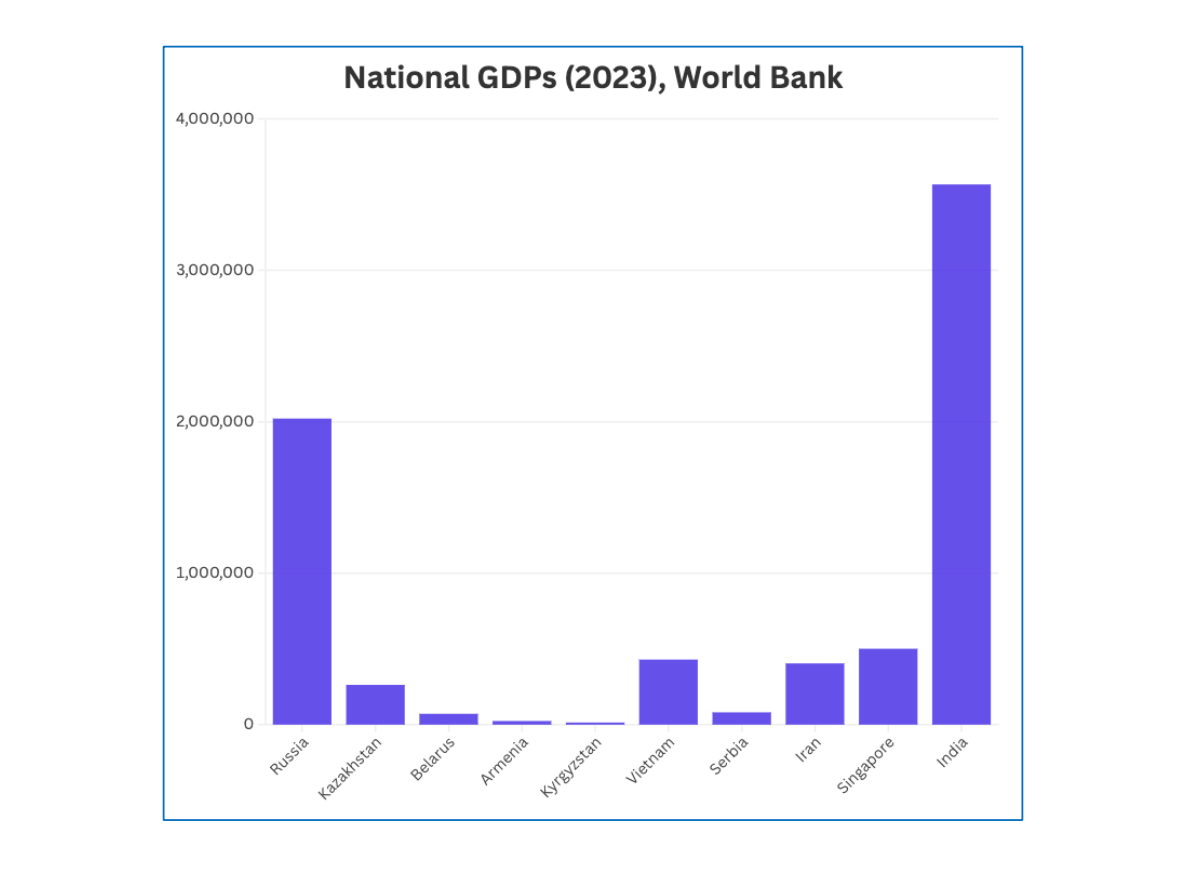An FTA Between India and the EAEU?
Recent Articles
Author: Nicholas Castillo
02/04/2025
Some policymakers are beginning to speak optimistically about India signing a free-trade agreement with the EAEU in 2025. Though pessimism has surrounded Russian-backed intergovernmental organizations in recent years, the Eurasian Economic Union (EAEU), made up of Russia, Belarus, Kazakhstan, Kyrgyzstan, and Armenia, might be on the upswing. Of the various bodies Moscow has created to maintain its influence in the post-Soviet space, only the EAEU has seen productive activity in recent years, while the Commonwealth of Independent States and Collective Security Treaty Organization are regularly described as feckless organizations in decline.
Russian Deputy Economic Development Minister Vladimir Ilichev claimed that policymakers have already informally “started discussions” over an India-EAEU free-trade agreement (FTA), with the hope that "official negotiations will commence this year.” Ilichev’s comments reflect those of India’s Additional Secretary in the Department of Commerce, Anant Swarup, who confirmed in July that the "[s]cope and the ToRs [terms of reference] of the proposed free-trade agreement are under stakeholder consultation internally in India and same with Russia, and soon it will be exchanged so that the next steps can take place.”
Discussion around Indian cooperation with the EAEU follow what was a productive year for the organization. Iran, which has a growing partnership with Russia, and which borders EAEU member state Armenia, signed an FTA with the body in 2024.
In addition to Iran, the EAEU has other FTAs with Vietnam (singed in 2015), Singapore (singed in early 2025), and Serbia (signed in 2021). A proposed EAEU FTA with China has also garnered attention, but that seems likely to be a more long-term prospect.
But a potential FTA with India would be far more significant than the one with Iran. With a population of 90 million and roughly a $400 billion GDP, Iran’s potential pales in comparison to India with its population of 1.4 billion and a GDP of $3.5 trillion. Widely expected to be one of the leading economies of the future, India’s current GDP is greater than that of all EAEU members combined. An FTA with India could have the potential to give the EAEU newfound relevance and importance. For Armenia, which is currently considering an EU application, the prospect of an FTA with India might provide powerful incentive to remain in the EAEU.
 However, if FTA negotiations open with New Delhi, it would likely be a year or more before they are finalized. Without any major Indian politicians explicitly endorsing an FTA, there remains room for skepticism around the idea of any EAEU FTA. India has maintained commercial and military relations with Russia since the installation of wide-spread anti-Moscow sanctions in 2022 because of the Kremlin’s invasion of Ukraine, but an FTA with a body associated with Russia and Iran could provoke an unwelcome response from the United States, one of India’s central partners. Companies doing business with Russia frequently face secondary sanctions, raising immediate risks for states and individual firms.
However, if FTA negotiations open with New Delhi, it would likely be a year or more before they are finalized. Without any major Indian politicians explicitly endorsing an FTA, there remains room for skepticism around the idea of any EAEU FTA. India has maintained commercial and military relations with Russia since the installation of wide-spread anti-Moscow sanctions in 2022 because of the Kremlin’s invasion of Ukraine, but an FTA with a body associated with Russia and Iran could provoke an unwelcome response from the United States, one of India’s central partners. Companies doing business with Russia frequently face secondary sanctions, raising immediate risks for states and individual firms.
The EAEU has not replicated the success of the European Union (EU), the organization it was meant to replicate and compete with. Arguably, the body is only a partial customs union, with minimal economic coordination. Russia’s economy is far larger than the others’, with Kazakhstan’s a distant second. Despite its handful of FTAs, the group has not expanded membership since its 2015 founding.
Furthermore, the Kremlin’s attempts to strongarm neighboring states into accession has not borne fruit. The decision by Ukrainian President Victor Yanukovich to forgo an EU agreement in favor of the EAEU sparked the 2014 protests that eventually led to his overthrow. Uzbekistan, within the post-Soviet neighborhood, has resisted pressure from Moscow to join. Last October, Uzbek officials again clarified that Uzbekistan would not be joining the EAEU, saying that Kazakhstan had seen only minor benefits from its membership.
Ironically, while the EAEU has attracted limited interest within the Kremlin’s intended regions of Eastern Europe and Central Asia, in the Global South it appears to be more attractive. Russia has worked hard to expand relations with this part of the world in recent years, and the EAEU appears to be a useful tool in that effort. If India moves forward with an FTA, it would be the most significant moment for the EAEU to date.